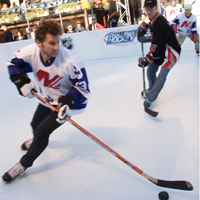
Synthetic ice, sometimes referred to as artificial ice (though “artificial ice” is a term used to describe the man-made skating surface created by freezing water with refrigeration equipment, as well), is a lightweight, low-friction, wear-resistant polymer (plastic) material used for skating with standard metal-bladed ice skates. A typical synthetic ice rink will consist of many panels (usually in typical building material sheet sizes) of thin surface material assembled on top of a sturdy, level and smooth sub-floor (anything from concrete to wood or even dirt or grass) to create a large skating area.
Synthetic ice has been around for many decades. It is an excellent alternative to real ice, which requires either cold weather to produce natural ice or expensive refrigeration equipment to freeze water. The first known application of modern plastics as a substitute for ice for the purpose of ice skating was in the 1960’s using materials such as polyoxymethylene plastic which was developed by DuPont in the early 1950’s.
Even now, you will find many synthetic ice products using the same generic polymers that were available in the 1960’s. These generic materials have some significant shortcomings. The most obvious being that skaters cannot glide on these surfaces as they can on real ice without the regular application of a silicone compound. This compound builds up on the surface, collects dirt and grime, and is the source of much dissatisfaction among those who have tried synthetic ice skating on rinks using the old technology.
Another shortcoming of early synthetic ice products was the methods used to join the panels. The earliest method was a simple butt joint with one flat panel butted against the next, leaving a joint that skaters could feel, or worse yet that a skate blade could catch in and trip the skater. Using simple splines on the straight-cut joint was an improvement on this, but variations in temperature could cause these joints to open up and cause the same problems. The latest technological advancement in synthetic ice panel edging is to use variations of a common dovetail joint to really hold the panels together and make the seems almost undetectable.
These shortcomings were enough to give synthetic ice a well-earned bad reputation throughout the 1970’s, 1980’s and 1990’s.
Perry Boskus, a man who has dedicated his life to ice sports, always liked the idea of synthetic ice. He tried the surfaces that were available in the early 1990’s and just like everyone else, found them lacking in many ways. He knew there had to be a better way, and he made it his personal goal to find a solution. Through years of research and development with chemical and mechanical engineers, and testing with a wide variety of skaters worldwide, he has succeeded with the invention of Super-Glide.
The Super-Glide surface is based on similar materials used in the past, but it is specifically engineered for skating. Super-Glide has even developed a unique lubricating product that can be applied to the surface to give it that last bit of glide-factor to feel just like ice! This lubricant is specifically designed to work with the characteristics of the Super-Glide surface and be absorbed by it so that the surface never feels sticky and does not attract contaminants.
Unlike previous synthetic ice products that were assembled from panels made from pouring liquid polymer into a mold and compressing it to form sheets of varying thickness and density, Super-Glide panels are formed by a process called extrusion, which yields panels of exactly the same thickness every time. Super-Glide also uses an innovative patented assembly method to ensure that the seams between panels are smooth and do not vary with temperature.
All of these things; the specially engineered polymer and lubricant, the precise production methods and the innovative assembly method; come together to make Super-Glide an almost magical synthetic ice surface that offers 99% of the skating feel of real ice. All of the problems Perry found with the old-technology synthetic ice have been resolved. Super-Glide IS the future of synthetic ice.
All text on THIS PAGE available under the terms of the GNU Free Documentation License
Copyright (c) 2008, Super-Glide, Inc. Permission is granted to copy, distribute and/or modify this document under the terms of the GNU Free Documentation License, Version 1.3 or any later version published by the Free Software Foundation. A copy of the license is included in the section entitled "GNU
Free Documentation License".